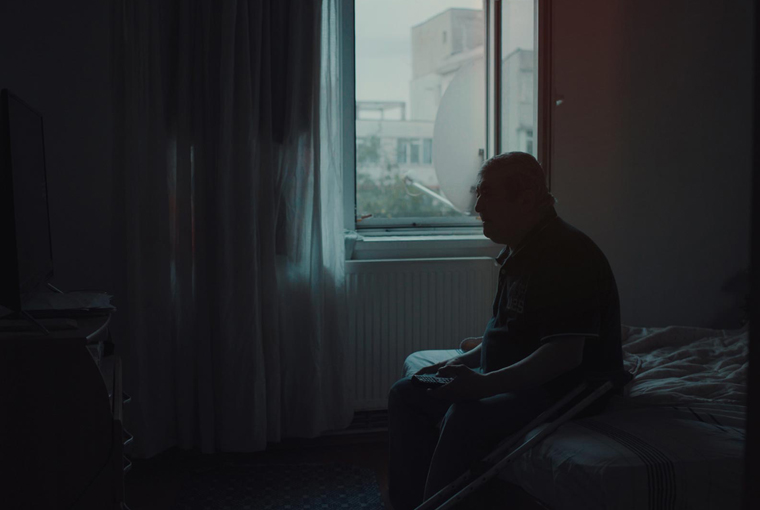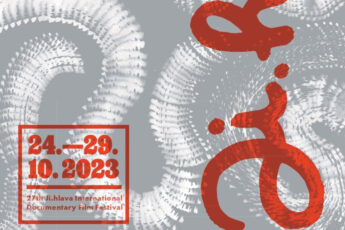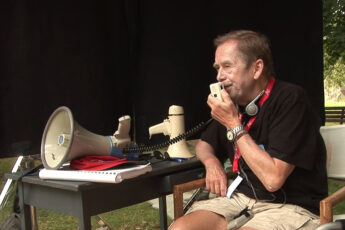The Mask of the Victim
Ilinca Calugareanu’s A Cautionary Tale (Cum să fiu mort, dacă-s viu?, 2023)
Vol. 142 (February 2024) by Martin Kudláč
In her latest docu-pic A Cautionary Tale, Romanian filmmaker Ilinca Călugăreanu stages a sparring match between herself and her protagonist. The documentary unfolds as a Kafkaesque narrative involving 63-year-old Romanian Constantin Reliu who encounters the absurdity of bureaucratic nightmares, culminating in a twist that challenges Călugăreanu’s role as a filmmaker and her relationship to her subject.
A Cautionary Tale is built on the promise of the stranger-than-fiction saga of Reliu, an average man entangled in a battle against the state’s bureaucratic machinery, whereby he has effectively joined the ranks of “the living dead”. Officially, he is recorded as deceased, yet he is very much alive, albeit stripped of access to state services. The documentary begins with Reliu’s deportation from Turkey, where he had spent 25 years working, and follows his return to his homeland in Romania. Upon the unceremonious homecoming, he discovers that he has been officially declared dead. The film chronicles Reliu’s strenuous efforts to bureaucratically prove his existence and reclaim his identity.
Călugăreanu’s approach in A Cautionary Tale channels the essence of early Romanian New Wave cinema, emphasizing the absurdities inherent in socio-political systems while crafting a metaphor for bureaucracy’s dehumanizing impact on our everyday lives. One could almost say the film’s narrative unspools as a documentary version of The Death of Mr. Lăzărescu (2005), though it diverges in pacing from Cristi Puiu’s acclaimed work. Constantin Reliu, the protagonist, finds himself at the mercy of an opaque system, possessing little to no power to alter his situation.
As Reliu engages in a seemingly hopeless battle against institutional indifference, Călugăreanu finds herself increasingly drawn into the protagonist’s orbit, transitioning from a detached observer to an active participant in the story. This shift not only intensifies the documentary’s emotional resonance but also moves Călugăreanu’s role towards that of an activist. Reliu’s struggle, characterized by both absurdity and frustration, serves as a poignant illustration of how individuals can become ensnared in the bureaucratic maze, prompting the director’s deeper involvement in aiding an ostensibly forgotten man.
Reliu initially presents himself in a manner that might seem unduly favorable. However, as Călugăreanu becomes more directly involved, the nature of the documentary transitions from straightforward portraiture to investigative reporting. Eventually, it goes so far as to adopt an outright activist stance. This progression is disrupted by a pivotal revelation that shifts the dynamic between the documentarist and the documented significantly. The observer, in this case Călugăreanu, transitions into an active participant by endeavoring to unravel the enigma surrounding Reliu, who turns out to be an unreliable narrator.
This twist transforms A Cautionary Tale into a metatextual documentary that seems to unfold almost in real-time. Călugăreanu is seen attempting to address Reliu’s deceitful accounts. As more individuals from Reliu’s life begin to contribute their perspectives, it becomes evident that the protagonist has omitted crucial information, striving to control his life narrative. Ultimately, A Cautionary Tale evolves into a story with dual narrators where personal experiences and collective reality collide, creating a psycho-social thriller that delves into the documentary-making process itself.
The director employs a minimalist approach, characterized by an austere, almost bare bones DIY aesthetic that imbues the documentary with a fitting sense of stark realism and authenticity. Călugăreanu draws on techniques from the formalistic toolbox of the Blair Witch Project as the dynamic between her and her subject evolves. This shift imparts a secondary, more complex meaning to the title, enhancing the documentary’s intrigue. What begins as a relatively straightforward narrative of an ordinary man contending with a bureaucratic system morphs into a layered mystery. This mystery revolves around Reliu’s obscure agency and the elusive purpose behind his interactions with Călugăreanu.
The authenticity of A Cautionary Tale becomes ambiguous as Călugăreanu persists with the documentary, despite the main subject taking an unpredictable turn. This uncertainty enriches the viewing experience, prompting viewers to ponder the boundaries between the filmmaker and the subject, the potential for intervention, and the reactions to subjects hijacking the documentarian’s efforts for their own opaque reasons, including attempts to redirect or spin the narrative.
This situation brings to the forefront ethical considerations regarding how to proceed when a subject changes course mid-production or intentionally deceives the filmmaker, potentially compromising the project and the integrity of the footage. It raises the question to what extent subjects can intentionally influence the documentarian’s creative process.
Despite these challenges, Călugăreanu extracts considerable mileage from what becomes a minimalist, almost DIY documentary project gone awry. Ultimately, A Cautionary Tale poses questions about the essence of documentary filmmaking and the nature of reality as captured through the lens. It subtly hints at the potential for subversion within the genre, examining how narratives can be shaped, reshaped, and sometimes derailed by the subjects they aim to document.




Leave a Comment